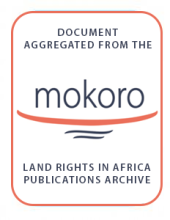Land Library
Welcome to the Land Portal Library. Explore our vast collection of open-access resources (over 74,000) including reports, journal articles, research papers, peer-reviewed publications, legal documents, videos and much more.
/ library resources
Showing items 127 through 135 of 1205.Publication shows how addressing land issues can mitigate conflict;facilitate solutions to it;improve the likelihood that people can return to their homes after the violence is over;and contribute to peace overall.
In 2008;the world food crisis shifted agricultural investment to countries with productive land and cheap labour. The Nacala Corridor;one of the most fertile and populated areas of Mozambique;was heavily affected.
Research in Sierra Leone reveals that the role of Paramount Chiefs and MPs in approaching communities for negotiations compromised Free;Prior and Informed Consent. Companies and local authority figures used vague references to ‘developmentto convince landowners to sign.
Examines the political economy of agricultural commercialisation in Malawi over the past three decades;which has been influenced to a very large extent by the changing configurations of political elites and their underlying interests;incentives and motivations;including using the agricultural sec
The Netherlands Land Academy (LANDac), the Food & Business Knowledge Platform, CIFOR and Shared Value Foundation (SVF) jointly set out in 2017 to design and implement 3 multi-stakeholder Learning Platforms around investment hubs in Mozambique (the Beira Corridor), Tanzania (Kilombero Valley)
Indigenous and community lands, crucial for rural livelihoods, are typically held under informal customary arrangements.
Report shows that Dutch-based banks continue to finance deforestation and land grabbing in Liberia. Thousands have lost their homes, local communities have been intimidated or imprisoned, and large swathes of forest have been cleared or burnt down.
GRAIN has documented at least 135 farmland deals for food crop production that have backfired between 2007 and 2017. They represent 17.5 million hectares. These are not failed land grabs, since the land almost never goes back to the communities, but failed agribusiness projects.
Includes the indigenous peoples of Ethiopia; Ethiopia’s dire context; food insecurity; land grabs, conflicts and food security; development by displacement I: Ethiopia’s land investment policies; table of land deals with foreign companies in Gambela since 2007; development by displacement II: Eth

